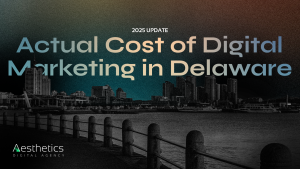In the fast-paced digital world, your website is often the first point of contact between your business and potential customers. A well-designed and functional website is crucial for leaving a lasting impression and attracting visitors. 94% of first impressions relate to your site’s web design. However, just like fashion trends, web design evolves, and what worked a few years ago might not be as effective today. In this blog post, we’ll explore five clear signs that indicate it’s high time for a website redesign.
What Is a Website Redesign?
A website redesign is more than a facelift; it’s a comprehensive makeover involving coding, content, structure, and visuals. The aim is to enhance functionality, aesthetics, and user engagement, ensuring your website remains a powerful tool in the digital landscape.
Website Redesign vs. Website Refresh
While the terms are often used interchangeably, there’s a key difference. A redesign involves a complete overhaul, addressing layout, design, content, and functionality.
On the other hand, a refresh is a surface-level update focused on the visual elements like color schemes, fonts, and images. Choose based on your goals – a complete transformation or a more subtle enhancement.
Looking for Signs: Do I Need Web Redesign Services?
Recognizing the signs early on is crucial. Here are the top five indicators that it’s time for a website redesign:
High Bounce Rate
A high bounce rate indicates that visitors are leaving your website after viewing only one page. This can be attributed to various factors, such as unengaging content, confusing navigation, or a lack of clear calls to action.
Read this blog if your visitors are leaving your website and not converting to customers.User experience (UX) is paramount in the online world. If visitors find it challenging to navigate your website, locate information, or complete actions like filling out forms or making purchases, they are likely to leave frustrated. Consider the flow of your website: Is it intuitive and user-friendly, or does it leave your audience scratching their heads?
Track user behavior through analytics. Are there high bounce rates on certain pages? Do users frequently abandon their shopping carts or leave your site without exploring further? Identifying pain points in the user journey can help pinpoint areas that need improvement.
Example
Let’s consider the example of an e-commerce website experiencing a high bounce rate.
Redesign Implementation
Clear Product Categories:
Implement clearer and more intuitive product categories. Ensure that visitors can easily find and explore the specific items they are interested in without unnecessary clicks.
Featured Items on Homepage:
Showcase featured items prominently on the homepage. A visually appealing display with persuasive captions like “Explore Our Latest Collections” encourages visitors to delve deeper into the product offerings.
Strategic CTAs:
Introduce persuasive calls to action strategically. For instance, strategically placed buttons with text like “Shop Now” or “Discover More” guide users toward exploring additional pages and products.
With these redesign considerations applied, the e-commerce website experiences a positive transformation. By prioritizing user experience and strategically addressing the causes of high bounce rates, businesses can create a favorable online environment that encourages visitor retention.
Outdated Design
Imagine walking into a store that hasn’t changed its interior decor in a decade. It’s likely that you would feel a bit out of touch with the times. The same principle applies to your website. An outdated design can make your business appear stagnant and unresponsive to current trends. Ask yourself, does your website look like it belongs in the past? If so, it might be time for a fresh and modern redesign.
Compare your website to industry leaders or successful competitors. Are they using modern design elements and engaging visuals that captivate their audience? If your site doesn’t measure up, it’s a clear sign that a redesign is in order.
Example
Consider a law firm website that still uses a dated color scheme and cluttered layout. A redesign could involve adopting a more minimalist design, utilizing elegant fonts, and incorporating high-quality images to convey professionalism and trust.
Redesign Implementation
Minimalist Design Approach:
Adopt a more minimalist design approach to streamline the website’s visual elements. A clean and uncluttered layout enhances the user experience and conveys a sense of professionalism.
Elegant Fonts:
Utilize elegant fonts such as Roboto or Lato to replace outdated and less readable font choices. This enhances the readability of the content and contributes to a more contemporary aesthetic.
Incorporate High-Quality Images:
Integrate high-quality images that resonate with the law firm’s brand and convey trustworthiness. Professionally taken photographs and images contribute to an overall polished appearance.
By addressing the issue of outdated design, businesses can ensure that their online presence remains visually appealing, relevant, and competitive in a digital landscape.
Non-Responsive Design
With the increasing use of smartphones and tablets, it’s crucial that your website looks and functions well on various devices. A non-responsive design can lead to a subpar experience for mobile users, potentially driving them away. Ask yourself, is your website optimized for all screen sizes and devices? If not, you need web redesign services.
Take out your smartphone and visit your website. Does it look as appealing and function as smoothly as it does on a desktop? If not, it’s time to invest in a responsive design that adapts to different screens.
If you’re using pre-made designs, choose responsive templates that automatically adjust the layout based on the screen size.
Example
Consider an e-commerce website specializing in fashion apparel. The current website was designed with desktop users in mind, featuring visually appealing product images, detailed descriptions, and an easy-to-navigate layout.
However, when accessed on a smartphone, the user experience takes a hit. The images appear too small, text is challenging to read, and navigation becomes difficult. This discrepancy in the user experience between desktop and mobile devices can lead to potential customers abandoning the site.
Redesign Considerations
Adjust Layout for Mobile Compatibility:
Revise the website layout to ensure that it adapts seamlessly to various screen sizes. This involves reorganizing content, rearranging product displays, and optimizing the overall structure for a more user-friendly mobile experience.
Use Larger Fonts for Readability:
Increase the font size to enhance readability on smaller screens. This adjustment is crucial for ensuring that users can easily read product descriptions, prices, and other essential information without the need for excessive zooming or scrolling.
Optimize Images for Mobile Viewing:
Resize and optimize product images specifically for mobile screens. This improves loading times and also ensures that the visual appeal of the products is maintained
Implement Responsive Templates:
If the website is built on pre-made designs, opt for responsive templates that automatically adjust the layout based on the screen size. This eliminates the need for manual adjustments and ensures a consistent and optimized experience across devices.
By addressing the non-responsive design issue through a thoughtful redesign, the online store not only enhances user satisfaction but also opens up new opportunities for mobile-driven sales.
Slow Loading Times
In today’s fast-paced world, users expect websites to load quickly. If your site takes too long to load, visitors may lose interest and move on. Slow loading times can also negatively impact your search engine rankings. Ask yourself, does your website load quickly, or do users find themselves waiting impatiently?
Use tools like Google PageSpeed Insights to analyze your website’s loading times. If the results indicate a sluggish performance, it’s a clear sign that a redesign focusing on speed optimization is necessary.
Example
Imagine an online news website that, due to its heavy reliance on images and plugins, experiences sluggish loading times. Users accessing the site, especially from different parts of the world, face delays in accessing articles, impacting their overall satisfaction.
Redesign Implementation
Content Delivery Network (CDN):
Integrate a CDN to optimize content delivery, ensuring that users, regardless of their location, experience faster loading times.
Plugin Audit:
Conduct a thorough audit of plugins, removing any that are unnecessary or contribute to the website’s sluggish performance. Prioritize essential plugins that enhance user experience and functionality.
Lazy Loading for Images:
Implement lazy loading for images, allowing articles to load more quickly initially and providing a seamless reading experience for users.
Changing Business Goals
As your company grows, diversifies its products or services, or targets a different audience, the alignment between your business goals and your website becomes crucial. Your website is not just a digital storefront; it’s a dynamic tool that should reflect the current state of your business. If your website no longer resonates with your evolving business goals, it’s a clear signal that you need web redesign services.
Your website is a primary means of communication between your brand and your audience. If it fails to effectively convey your brand message, it’s likely to create confusion and a sense of disconnect. A well-designed website harmonizes visual elements, messaging, and functionality to communicate your brand identity clearly.
Businesses often set on new initiatives, whether it’s sustainability efforts or community engagement programs. If your website doesn’t highlight these initiatives, you’re missing an opportunity to showcase your company values and connect with a socially conscious audience.
Example
Imagine you run a small bakery that has recently expanded its offerings to include gluten-free and vegan options due to the increasing demand for healthier alternatives. However, your website still prominently features only traditional baked goods.
Redesign Considerations
Revise your website to prominently feature the new gluten-free and vegan products on the homepage and relevant product pages.
Highlight Health-Conscious Messaging. Adjust the messaging across your website to emphasize the health benefits of your new offerings.
If your audience has shifted towards health-conscious consumers, ensure that your website engages them with relevant content, testimonials, or blog posts about the benefits of your new products.
Conclusion
In the ever-changing world of the internet, your website is like a virtual store. It’s not just a place to show what you have; it’s also how people see your brand. It plays a big role in making your business work well. Checking your website regularly and fixing it up when needed makes sure it stays useful and keeps people interested. So, think about these questions, look at your website, and if it needs it, go ahead with website redesign. A website that’s new and interesting is not just about being online; it’s about helping your business grow and do well.







